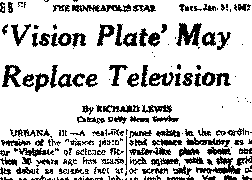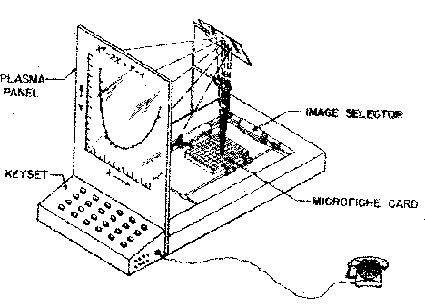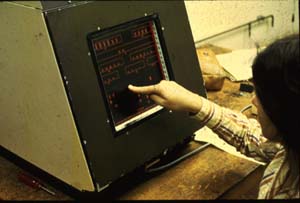The History of Plasma Displays
By Jamie Hutchinson
Patent attorney Nate Scarpelli (BSEE '58) was new to
the Chicago law firm of Merriam Marshall Shapiro Klose
when the firm assigned him the task of patenting PLATO,
the plasma display, and other ideas for the U of I.
The "Merriam" was Charles Merriam, who sat
on the board of the U of I Foundation and was the driving
force behind University Patents, originally set up within
the Foundation to license U of I patents, but later
spun-off into the publicly held University Patents,
Inc. The push was on to commercialize U of I technologies—a
new and controversial course for the century-old land
grant institution—with an eye toward building
the university's endowment.
Although the first patent covering the fundamental
operation and applications of the plasma display panel
was not granted until 1971 ("one of the most complete
applications I think I've ever done," recalls Scarpelli),
U of I began collecting on the technology as early as
1967. That year U of I sold an exclusive license to
the Owens-Illinois glass company, which would deliver
the first commercial-grade "Digivue" displays
for use in PLATO in 1971.
 An Owens-Illinois "Digivue" panel with
electronics exposed. (Owens-Illinois)
An Owens-Illinois "Digivue" panel with
electronics exposed. (Owens-Illinois)IBM took an early interest as well, and the lure of
Big Blue's prestige and deep pockets forced Merriam
and Alpert into some ticklish negotiations between the
two corporate players, with the happy result that U
of I collected a million dollars from IBM in exchange
for another license. That license would lead in 1983
to the IBM 3290 Information Panel, "the industry's
first mass-produced, large-screen plasma display terminal
for commercial use," according to an IBM advertisement.
TV companies including RCA, Zenith, and General Electric
took notice of early press reports about plasma displays
as potential "hang-on-the-wall" TVs. Some
took out licenses, but they all sent visitors to see
what was happening at CERL. Zenith provided the phosphors
for Edward Stredde's (BSEE '66, MSEE '68) master's work
on a multicolor plasma display.
 Early press reports prophesied plasma's potential
as a new TV display technology. This article from the
Minneapolis Star pointed out the role of Minneapolis-based
Control Data Corporation in PLATO. A CDC computer replaced
ILLIAC as the PLATO mainframe, and the company bought
limited rights to the PLATO name in the late 1960s.
(Minneapolis Star)
Early press reports prophesied plasma's potential
as a new TV display technology. This article from the
Minneapolis Star pointed out the role of Minneapolis-based
Control Data Corporation in PLATO. A CDC computer replaced
ILLIAC as the PLATO mainframe, and the company bought
limited rights to the PLATO name in the late 1960s.
(Minneapolis Star) After finishing his PhD in 1975 with a
dissertation on the discharge dynamics of plasma displays,
Weber joined the CERL staff and began consulting to
U.S. companies interested in such commercial applications
of the Illinois technology.
Another CERL alum, Roger Johnson (BSEE
'65, MSEE '66, PhD '70) joined the ECE faculty in 1971
and found his consulting home in the Pentagon and its
contractors, which included Magnavox, Science Applications
International (now SAIC), and the Owens-Illinois spin-off
Photonics Systems. Johnson would leave his faculty post
in 1977 and spend the next 25 years at SAIC developing
flat displays and mobile workstations. In 1982, the
company manufactured its "Plasmascope" displays
for controlling ground-launched cruise missiles. The
displays were "nuclear hardened" to withstand
the radioactive environment of a nuclear war. Similar
displays went into the Trident nuclear attack submarine
and the "Doomsday Plane"—officially
known as the Advanced Airborne Command Post, a Boeing
747 outfitted to control U.S. forces in a nuclear war.
Photonics and Magnavox collaborated on the largest plasma
displays of the time, status boards used by the Air
Force to monitor air operations.
Japanese companies were among the first
to take out licenses and begin their own plasma display
research, enjoying the support and encouragement of
NHK, the government broadcasting system that had advocated
HDTV as early as the 1960s. Among the prominent Japanese
engineers who visited CERL to study plasma displays
was Heiji Uchiike, now of Saga University. Uchiike spent
a year at CERL in the early days of the plasma display
and has gone on to train many of the top plasma engineers
in Japan. Japanese companies who sent visitors to CERL,
many of them staying for extended periods, include Fujitsu,
Hitachi, Matsushita, Sony, NEC, and even NHK. These
companies, especially Fujitsu, have made important developments
based on the fundamental ideas that came out of Illinois.
Bitzer noted that the Japanese also saw
plasma as an answer to the problem of displaying their
Kanji script, something the Western alphanumeric computer
displays of the early 1960s could not do. So plasma
panels became widely used in Japan for cash registers,
meters, and public signs.

The transparency of the monochrome plasma displays allowed
slides to be superimposed on images read from the computer.

Infrared light-emitting diodes on the perimeter of a
PLATO "smart" plasma screen could sense the
position of a finger. Bitzer summed up the functionality
of the PLATO stations: "It spoke, it recorded—if
you were teaching a foreign language, you could hear
your own voice. It had touch, it had rear projected
images, and graphics. You just had to like orange a
lot for the graphics." (D. L. Bitzer)
|